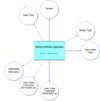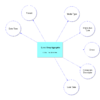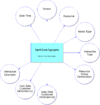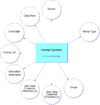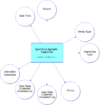Reporting And Analytics Aggregates
Also known as RAA. An optional Genesys Info Mart process that creates and populates predefined aggregation tables and views within an Info Mart database. RAA aggregation tables and views provide the metrics that summarize contact center activity to facilitate reporting, and serves as the primary source of data for the Genesys CX Insights (GCXI) historical reports. RAA is required for Genesys CX Insights, and was required for the now-deprecated GI2.
Glossary
Contents
How Do Subject Area Hierarchies Work?
This page provides diagrams that depict the Reporting and Analytics Aggregates (RAA) hierarchies (described in What is an Aggregation Hierarchy?). For a more technical discussion of each subject area, refer to the Reporting and Analytics Aggregates Reference Manual and the relevant Genesys Info Mart Reference Manual for descriptions of the dimension tables that are depicted on this page.
Aggregation Hierarchies
Figures on this page are thumbnails. Click any of them to view a full-sized version.
Subject Area for Business Attribute Aggregates
This subject area provides aggregated measures for interactions that are assigned a specific predefined business attribute. Rollups are based on media type and interaction type and are attributed to the reporting interval in which the interactions entered or began within the contact center. You can also configure custom user data by which to dimension the aggregates of this subject area. This subject area supports the H_ID hierarchy.
Subject Area for Session State Aggregates
This subject area provides aggregated measures of summarized agent states based on the media type that is associated with the agent session. Summarized agent sessions consider the collective state of all devices to which the agent has logged in for a particular media type. Following the Interval-Based Measures model, measures from this subject area are attributed to all intervals in which the agent states were active within a session. This subject area supports the H_I_SESS_STATE hierarchy.
Subject Area for State Reason Aggregates
This subject area provides aggregated measures of summarized agent states that were ascribed a particular reason code. Rollups are based on the media type that is associated with the agent session. Following the Interval-Based Measures model, measures from this subject area are attributed to all intervals in which the reason codes for the agent states were active within a session. This subject area supports the H_I_STATE_RSN hierarchy.
Subject Area for Queue Aggregates
This subject area provides aggregated measures for interactions that pass through a specific queue, as viewed from the perspective of that queue. Supported queue types include: ACD queues, virtual queues, interaction queues, and interaction workbins. Rollups are based on media type and interaction type and are attributed to the reporting interval in which the interactions entered the queue. This subject area supports the H_QUEUE hierarchy.
Subject Area for Queue Group Aggregates
This subject area provides aggregated measures for interactions that pass through queues that belong to a specific queue group, as viewed from the perspective of those queues. Rollups are based on media type and interaction type and are attributed to the reporting interval in which the interactions entered the queue group. This subject area supports the H_QUEUE_GRP hierarchy.
Subject Area for Abandoned-in-Queue Aggregates
This subject area provides aggregated measures for interactions that were abandoned within a specific queue, sorting their duration in queue into 20 time-range buckets. Rollups are based on media type and interaction type and are attributed to the reporting interval in which the interactions entered the queue. Aggregates include interactions that were abandoned within the short-abandoned threshold and exclude those that were abandoned immediately following distribution, such as abandoned-while-ringing interactions. This subject area supports the H_QUEUE_ABN hierarchy.
Subject Area for Speed-of-Accept Aggregates
This subject area provides aggregated measures for interactions that were distributed from a specific queue and accepted by agent resources, sorting their durations from distribution queue to acceptance into 20 time-range buckets. Rollups are based on media type and interaction type and are attributed to the reporting interval in which the interactions entered the queue. Note that these aggregates do not reflect the customer’s overall wait time, as they do not include the duration that interactions spent at other queue objects before they reached the specific queue from which they were distributed. This subject area supports the H_QUEUE_ACC_AGENT hierarchy.
Subject Area for Agent Queue Aggregates
This subject area provides aggregated measures of the interaction-handling activities of a specific agent where the interactions were distributed from a specific queue from one of the supported queue-type objects. Rollups for this agent/queue combination are based on key business attributes, media type, and interaction type and are attributed to the interval in which the agent received contact center interactions. You can also configure custom user data by which to dimension the aggregates of this subject area. The model references the Resource dimension twice—once, to ascertain from which queue that interactions were distributed, and once more to ascertain which agents received the interactions. Likewise, the Resource Group Combination dimension is referenced twice—once, to identify the queue-resource groups to which the queue belonged when interactions enter the queue, and once more to identify the agent-resource groups to which the agents belonged when they received the interactions. This subject area supports the H_AGENT_QUEUE hierarchy.
Subject Area for Agent Campaign Aggregates
This subject area provides aggregated measures of the interaction-handling activities of a specific agent where the interactions originated from a specific Genesys Outbound Contact campaign. Rollups are based both on interaction resource facts and the disposition of the contact attempts to reach customers that were generated by the campaign. Rollups are attributed to the interval in which the contact attempts were initiated by or on the behalf the agent. You can also configure custom user data by which to dimension the aggregates of this subject area. This subject area supports the H_AGENT_CAMPAIGN hierarchy.
Subject Area for Campaign Aggregates
This subject area provides aggregated measures of the various call results of interactions that are initiated by a specific Genesys Outbound Contact campaign. Rollups are based on the contact attempts and calling lists that are used to dial Outbound Contact voice interactions and are attributed to the interval in which the campaign group sessions began. You can also configure custom user data by which to dimension the aggregates of this subject area. This subject area supports the H_CAMPAIGN hierarchy.
Subject Area for Agent Aggregates
This subject area provides aggregated measures of the interaction-handling activities that are performed by a specific contact center agent. Rollups are based on key, predefined business attributes (business result, customer segment, service type, and service subtype), media type, and interaction type and are attributed to the reporting interval in which the agent received contact center interactions. You can also configure custom user data by which to dimension the aggregates of this subject area. This subject area supports the H_AGENT hierarchy.
Subject Area for Agent Group Aggregates
This subject area provides aggregated measures of the interaction-handling activities of all agents who belong to a particular agent group. Rollups are based on key business attributes, media type, and interaction type and are attributed to the interval in which group members received contact center interactions. You can also configure custom user data by which to dimension the aggregates of this subject area. This subject area supports the H_AGENT_GRP hierarchy.
Subject Area for Agent Interval Aggregates
Like the Agent Aggregates subject area the Agent-Interval subject area also provides aggregated measures of the interaction-handling activities of agents. Rollups are based on media type and interaction type but they are not based on key business attributes, as they are within the Agent Aggregates subject area. The more distinguishing characteristic that differentiates the two, however, is the perspective from which the aggregates are prepared. Aggregate measures in the Agent Interval subject area are attributed to all intervals in which the agent processed contact center interactions—not exclusively to the interval in which the agent received the interactions. Refer to the Genesys Info Mart documentation set for more information about disposition versus interval measures. This subject area supports the H_I_AGENT hierarchy.
Aggregate Tables Bus Matrix
The following table summarizes the dimension tables that join to the aggregates in a bus matrix.
| Dimension Tables | ||||||||||||||||
|---|---|---|---|---|---|---|---|---|---|---|---|---|---|---|---|---|
| Hierarchies | Calling List | Campaign | Date and Time | Group | Interaction Descriptor | Interaction Type | Media Type | Reason Code | Resource | Resource Group Combination | Resource State | Tenant | Time Range | User Data | Workbin | |
| Business Attribute Activity | Tenant | ✓ | ✓ | ✓ | ✓ | ✓ | ✓ | |||||||||
| Sessions, States, State Reasons | Session State | ✓ | ✓ | ✓ | ✓ | ✓ | ||||||||||
| State Reason | ✓ | ✓ | ✓ | ✓ | ✓ | ✓ | ✓ | |||||||||
| Queue Activity | Individual Queue | ✓ | ✓ | ✓ | ✓ | ✓ | ✓ | ✓ | ✓ | ✓ | ||||||
| Abandoned in Queue | ✓ | ✓ | ✓ | ✓ | ✓ | ✓ | ✓ | ✓ | ✓ | ✓ | ||||||
| Speed of Accept | ✓ | ✓ | ✓ | ✓ | ✓ | ✓ | ✓ | ✓ | ✓ | ✓ | ||||||
| Queue Group | ✓ | ✓ | ✓ | ✓ | ✓ | ✓ | ✓ | |||||||||
| Agent Activity | Agent-Queue Combination | ✓ | ✓ | ✓ | ✓ | ✓ | ✓ | ✓ | ✓ | |||||||
| Individual Agent | ✓ | ✓ | ✓ | ✓ | ✓ | ✓ | ✓ | ✓ | ||||||||
| Agent Group | ✓ | ✓ | ✓ | ✓ | ✓ | ✓ | ✓ | |||||||||
| Agent Interval | ✓ | ✓ | ✓ | ✓ | ✓ | ✓ | ||||||||||
| Campaign Activity | Agent | ✓ | ✓ | ✓ | ✓ | ✓ | ✓ | ✓ | ✓ | ✓ | ✓ | |||||
| Contact Attempt | ✓ | ✓ | ✓ | ✓ | ✓ | ✓ | ✓ | ✓ | ||||||||

